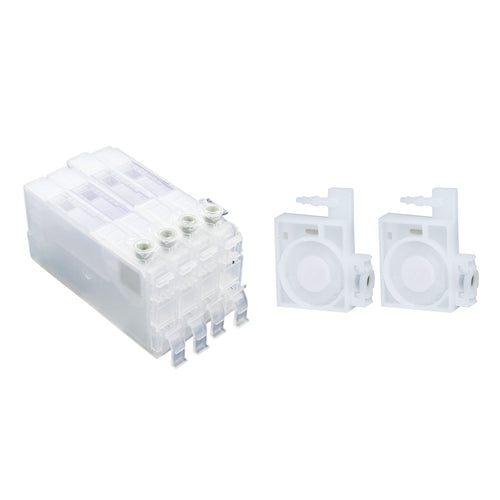1. Introduction
3D printing and DTF printing are two highly popular technologies and are often the first technical choices for entrepreneurs considering entering the custom printing industry. Both have different advantages and application scenarios. This article will help you grasp key technologies in the customization industry. We'll explore them from simple and clear angles.
2. What is 3D Printing and DTF Printing?
3D Printing:
3D printing, also known as additive manufacturing, creates real objects from digital designs. It builds them up layer by layer. The process starts with a 3D model created in computer-aided design (CAD) software. The model is then divided into thin layers. The printer adds material, such as plastic, resin, or metal powder, one layer at a time. This continues until the entire object is formed. Unlike traditional machining, 3D printing builds objects by adding material, not removing it. This allows for the creation of complex and detailed structures. Although the process can be complex, it offers unique benefits.
DTF Printing:
DTF printing, or Direct-to-Film Printing, uses water-based inks and transfer films. It employs heat transfer technology to move designs from the film to fabric. The process involves:
- Design: First, create a design with graphic design software like Photoshop.
Printing: A DTF printer prints the design onto a special PET film.
Powder Coating and Curing: After printing, we apply a layer of adhesive powder to the DTF film. We use a DTF oven to ensure a strong bond between the DTF ink and the film.
Heat Transfer: Then, the design is applied to fabric by a heat press. It can be applied on things like T-shirts or hats.
DTF printing has several benefits. It is fast and inexpensive. Plus, it can transfer high-quality designs to many fabrics. This makes it great for different orders, especially for home-based startups.
3. Comparison of 3D Printing and DTF Printing Consumables
The consumables play a crucial role when choosing a printing technology. Consumables greatly impact a company’s costs and its social responsibility. Here’s a comparison of the consumables for 3D printing and DTF printing. We will look at price and environmental impact.
3D Printing Consumables
Price:
PLA (Polylactic Acid) is the most common 3D printing material. It costs around $15 to $45 USD per kg.
ABS (Acrylonitrile Butadiene Styrene): Typically priced between $22-59 USD per kg.
Resin for photopolymer printing costs about $45 to $150 USD per kg. The price varies by brand and properties.
Metal powders: Can be much more expensive, ranging from $147-735 USD per kg, depending on the metal type.
Environmental:
PLA is a biodegradable material derived from plant-based sources, such as corn starch. It's more environmentally friendly and emits minimal harmful gases when burned.
ABS comes from petroleum. It’s tough to break down, so it releases harmful gases when processed. This creates environmental risks.
When they cure, resins, especially photopolymer ones, can release volatile organic compounds (VOCs). Without good ventilation, these compounds can be dangerous.
Metal powders can be harmful to the environment, especially when handled and recycled. Dust pollution is a significant problem.
DTF Printing Consumables
Price:
- DTF inks usually cost between $20 and $100 per bottle. Each bottle can print hundreds of designs. The exact price varies by brand and type.
PET film typically costs $0.15–$0.30 USD per sheet for transferring designs to fabric.
Transfer powder costs about $0.07–$0.15 USD per gram, and the usage amount will affect the cost per item.
Environmental:
- DTF inks and transfer powders are mostly water-based and heat-melt. They are friendlier to the environment than oil-based inks. This means they release fewer harmful gases.
PET film is a plastic, but it can be recycled. It also doesn’t release harmful substances during printing.
4. 3D Printing vs. DTF Printing – Differences in Design Software
The design software you choose affects how efficiently you can produce prints. 3D printing and DTF printing need different software tools. The learning curve and difficulty can be quite different too. DTF printing design software is generally easier to learn. In contrast, 3D printing modeling software takes more time to master.
Learning Curve:

DTF printers mostly use RIP software, Photoshop (PS), and other graphic design tools. These programs are easy to understand. Many users are familiar with these tools, so beginners can easily pick up the basics.
3D printing needs 3D modeling and slicing software, like Fusion 360 or Simplify3D. You must understand modeling, adjust parameters, and set up supports. Typically, it takes several weeks to months to master these tools.
Use of Software:

DTF printing starts with creating designs in Photoshop or similar software. Next, you process the colors and printing formats with RIP software. This software then directly outputs your design. The process is similar to common graphic design, with a straightforward logic. Some DTF printer suppliers also provide tutorials and remote video guidance, like the Inksonic tutorial video.
3D printing starts with creating a model. You need to adjust the model, optimize the supports, and slice it. Each step involves technical details. If the model isn’t optimal, it may need to be modified repeatedly, affecting production efficiency.
Target Audience:
DTF printers are perfect for entrepreneurs in personalized clothing, online sellers, and designers. They can start quickly, even without any special training.
3D printing takes some knowledge of math modeling and adjusting parameters.
5. 3D Printing vs. DTF Printing – Speed Comparison
Speed is a critical factor in determining production efficiency when choosing printing equipment. 3D printing and DTF printing have key differences. They differ in how printing flows, the steps involved, and their overall efficiency.
Printing Process:
The 3D printing involves several steps:
- Create the model
Slice it
Print the layers
Remove supports
Finish the surface
The DTF printing includes these steps:
Design
Direct printing on PET film
Powder coating
Curing
Heat transfer onto fabric
Printing Time Comparison:
3D printing usually builds a single object layer by layer, and even multiple parts must be printed sequentially. By the way, in 3D printing, speed is typically measured in "millimeters per hour" (mm/h). So printing time for each part ranges from several hours to a whole day.
DTF printers can print several designs on one PET film. And in DTF printing, speed is typically measured in "square meters per hour" (m²/h). They also speed up batch transfers, which boosts production efficiency.
DTF printers are better for commercial production. If you need high efficiency and quick delivery, choose DTF printers. However, when it comes to 3D printing, it is undeniable that it offers unparalleled precision and versatility in three-dimensional designs.
6. 3D Printing vs. DTF Printing – Application Scenarios
3D printing and DTF printing have a wide range of applications across industries. The main difference between the two lies in the consumables used and the media they apply to. Below is an introduction to the application scenarios of these two technologies and their consumables.
Core Applications of 3D Printing
3D printing is common in many fields. It helps create physical objects from digital models. Different materials are used based on the application.
Industrial Manufacturing: 3D printing makes it easy to create complex parts and prototype molds. These are often hard or even impossible to make with traditional methods. Common materials are resin, PLA, and metal powders. They are used for strong and precise machine parts, automotive parts, and aerospace products.
Medical: 3D printing helps customize prosthetics and surgical models. This allows doctors to offer personalized treatment. Biocompatible resins are commonly used to ensure safety and precision.
Education/Architecture: 3D printing can create teaching models and scale models for architecture. This includes miniature building prototypes and interactive displays for classrooms. Common materials include PLA and ABS for educational tools and display models.
Consumer Goods: 3D printing creates unique jewelry, home items, and custom products for consumers. Common materials include resin, plastic filaments, and sometimes metal alloys for intricate designs.
Main Applications of DTF Printing
DTF printing mainly targets the textile industry and custom printing. It uses simple supplies like inks and transfer films.
Apparel Industry: DTF printing is widely used for T-shirt, hat, and canvas bag printing. The consumables are special inks and PET transfer films. They help create bright, long-lasting designs on fabric.
Advertising Industry: DTF printing is used for customizing posters, signs, and promotional items. The technology is flexible. It can create large, high-quality prints. This makes it great for marketing and advertising campaigns.
Small Batch Production: DTF printing works well for short runs and fast orders. It’s ideal for custom limited editions, merchandise, or promotional materials. The process is fast and efficient. This makes it great for businesses that must respond quickly to market needs.
7. Comparison of 3D Printing and DTF Printing Quick Overview
Comparison Item |
3D Printing |
DTF Printing |
Definition |
3D printing, additive manufacturing, converting digital design files into physical objects layer by layer |
Direct-to-film printing, transferring designs from a film to fabric using heat transfer technology |
Application Scenarios |
Industrial manufacturing, medical, architecture, consumer goods customization, etc. |
Textile printing, advertising printing, small-batch custom products |
Print Accuracy |
High, suitable for complex parts and prototype manufacturing |
Medium, suitable for high-quality design transfer, especially for textiles |
Print Speed |
Slow, layer-by-layer accumulation, suitable for small-batch and high-precision products |
Fast, prints 1-3 square meters per minute, suitable for batch production |
Materials |
PLA, ABS, resin, metal powder, etc., expensive |
DTF ink, PET film, transfer powder, relatively inexpensive |
Cost |
High equipment and material costs, suitable for industrial and professional needs |
Moderate equipment cost, low material cost, suitable for small-scale startups and custom production |
Environmental Impact |
PLA is eco-friendly, ABS, resin, and metal powders have significant environmental impact |
Water-based inks and transfer powders are environmentally friendly, PET film is recyclable |
Difficulty of Operation |
Requires professional modeling software (e.g., Fusion 360, Simplify3D), complex operation |
Uses graphic design software (e.g., Photoshop), relatively simple and easy to master |
Target Audience |
Professionals, engineers, designers, manufacturers |
Personalized clothing entrepreneurs, e-commerce sellers, designers |
Design Software |
3D modeling and slicing software (e.g., Fusion 360, Simplify3D), long learning curve |
Graphic design software (e.g., Photoshop), intuitive and simple to use |
Printing Process |
Model design → slicing → layer printing → support removal → surface treatment |
Design pattern → print onto PET film → powder coating → heat transfer onto fabric |
Printing Time |
Small models: 3-6 hours, larger structures: 12-48 hours or more |
Prints 1-3 square meters per minute, transfers a T-shirt design in seconds |
Application Range |
Complex parts, medical prosthetics, educational models, etc., high-precision fields |
Textile customization (T-shirts, hats), advertising printing, short-run production |
Cost Structure |
Expensive equipment and materials, suitable for industrial-grade applications |
Moderate equipment price, low material costs, suitable for small-batch custom orders |
Maintenance & Support |
Requires professional technicians for maintenance and support |
Easy to maintain, manufacturers provide technical support |
Market Positioning |
Industrial manufacturing, medical, aerospace, and other high-end industries |
Small-batch customization, startups, quick response to market demand |
8. Conclusion
In summary, DTF printing is more suitable for fast and cost-effective fabric printing. It offers quick production cycles, simple design software, and eco-friendly consumables, making it ideal for small businesses and entrepreneurs.
Planning for 2025? Use our fastest marketing calendar to seize key opportunities. Or dive into The Ultimate Guide to Starting a T-Shirt Business in 2025 for expert success tips!
































